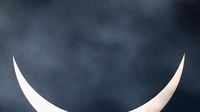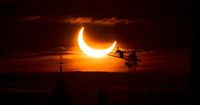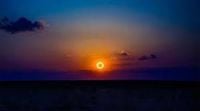A partial solar eclipse and double sunrise will occur this weekend, specifically on March 29-30, 2025. This rare astronomical event promises to offer a spectacular view, especially for those located in northeastern North America.
The first solar eclipse of the year will take place on Saturday, March 29. Unlike the total solar eclipse on April 8, 2024, this one will only be seen as a partial eclipse from parts of 13 U.S. states. While there will be no totality and it will not get dark, the highlight of the event will be an eclipsed sunrise, where observers may witness a unique visual phenomenon.
As the moon passes between Earth and the sun, it will obscure varying portions of the sun, ranging from as little as 1% to as much as 85% depending on the observer's location. Northern Quebec, Canada, is expected to experience the most significant coverage, with nearly 94% of the sun eclipsed during sunrise.
This partial solar eclipse will be visible in the U.S. from 6:13 to 7:17 a.m. EDT and in Canada from 6:56 a.m. NDT to 8:20 a.m. EDT. The exact timing can vary by location, so eclipse chasers are encouraged to check detailed schedules for their specific area using resources like Timeanddate.com.
In the northeastern U.S., states such as Maine, New Hampshire, Vermont, and Massachusetts will witness the most dramatic effects, with views of the eclipsed sunrise likely from coastal areas. The phenomenon known as "devil's horns"—where two cusps of the sun are visible on either side of the moon's silhouette—will be particularly striking for those near the U.S.-Canada border in Maine and New Brunswick, as well as along the St. Lawrence River in Quebec.
Several large cities will also experience this eclipse at sunrise, including New York City, where approximately 22% of the sun will be obscured. Boston will see about 43% coverage, while Concord, NH, will witness 46%, and Portland, ME, will experience a 64% eclipse. Washington, D.C., and Buffalo, NY, will be on the edge of the action, with only a 1% eclipse visible at sunrise.
For those unable to view the eclipse in person, live streams will be available from various locations, including Timeanddate.com, which will broadcast from Saint John in New Brunswick (84% coverage), Siena, Tuscany (5%), and Skibotn, Norway (37%). The Royal Observatory in Greenwich, London, will also provide a live stream with an estimated 31% eclipse coverage.
As the eclipse approaches, many are curious about how to safely capture this celestial event using smartphones. According to NASA, pointing an unprotected phone directly at the sun can damage its sensor. To avoid this, it is recommended to hold a pair of eclipse glasses in front of the phone's lens while photographing the sun during the eclipse.
NASA has shared tips for those looking to capture images of the eclipse, especially when the sun is partially obscured. For best results, using a special solar filter is essential. If a telephoto zoom lens is not available, photographers should focus on landscape shots that capture the changing environment. A tripod can help stabilize the camera and reduce blur during low-light conditions, and using a delayed shutter release timer can further enhance image quality.
In addition to photographing the eclipse, observers are encouraged to capture the human experience surrounding the event. NASA photographer Bill Ingalls noted, "The real pictures are going to be of the people around you pointing, gawking, and watching it. Those are going to be some great moments to capture to show the emotion of the whole thing."
Safety is paramount during a solar eclipse. Observers should never look directly at the sun without proper eye protection, as harmful ultraviolet (UV) and infrared (IR) rays can damage the retina and potentially cause blindness. The only safe way to view the sun directly is through specially designed solar filters, such as solar eclipse glasses.
As the weekend approaches, excitement builds for this unique astronomical event. The partial solar eclipse on March 29 will not only offer stunning visuals but will also create an opportunity for communities to come together and share in the wonder of the cosmos. Whether through live streams or in-person observations, this weekend promises to be memorable for stargazers and casual observers alike.
In summary, the partial solar eclipse this weekend will provide an exciting opportunity for viewers across North America, especially in northeastern states and parts of Canada. With the potential for a "double sunrise" and significant eclipse coverage, this event is not to be missed. Observers should prepare accordingly, ensuring they have the proper equipment and safety measures in place to enjoy this rare celestial display.







